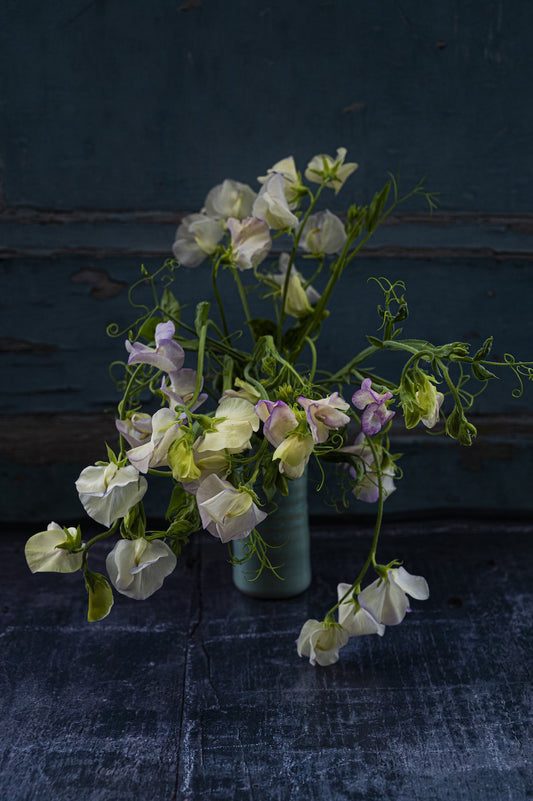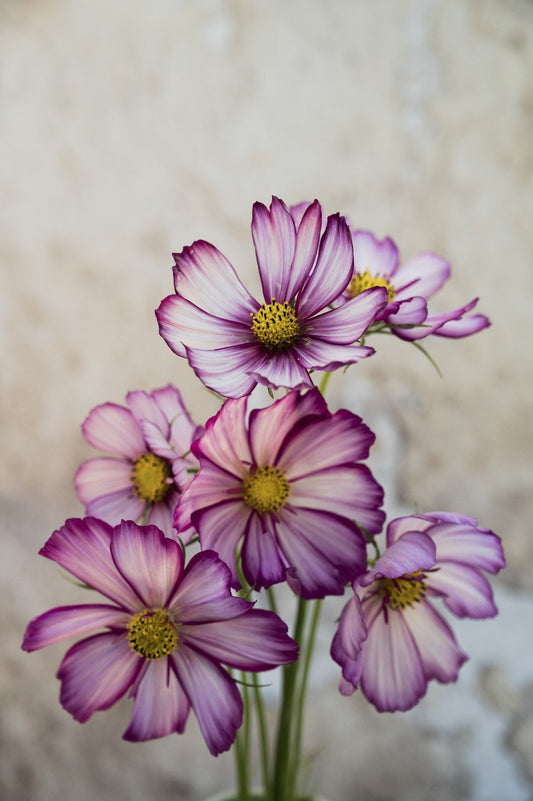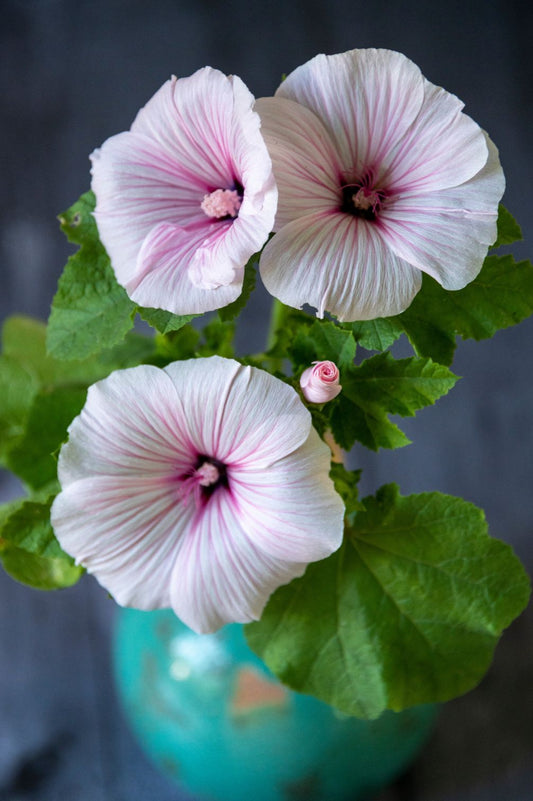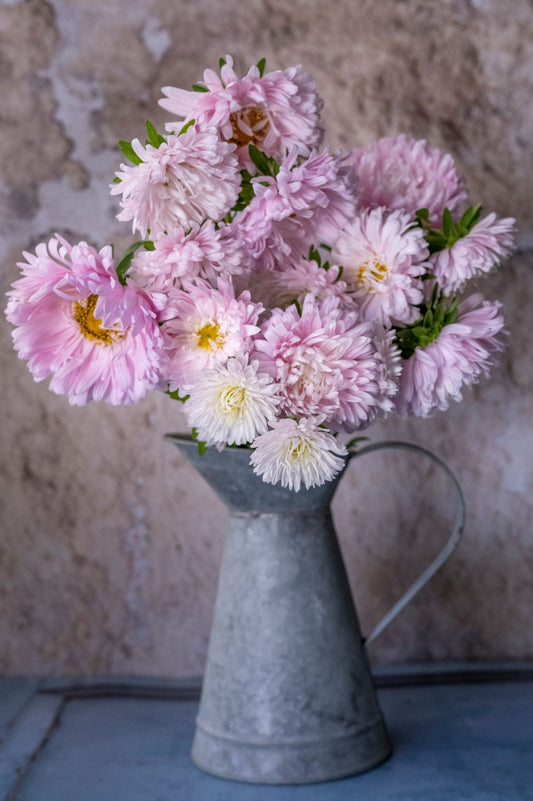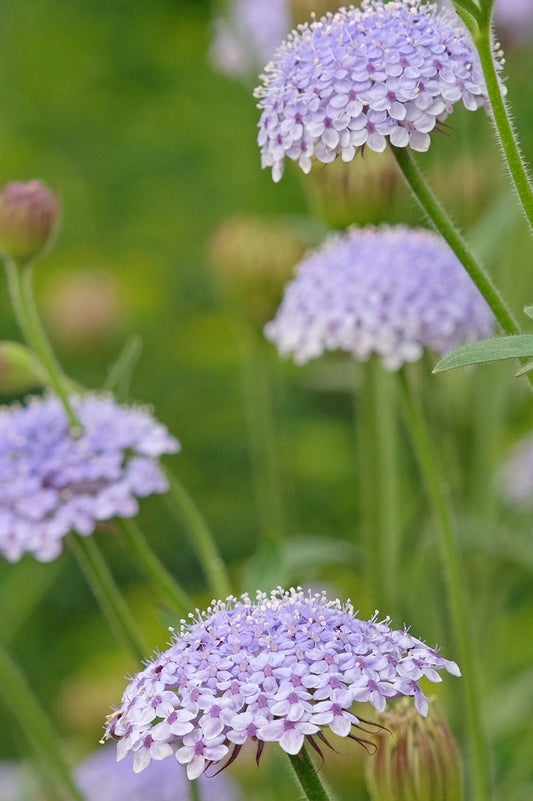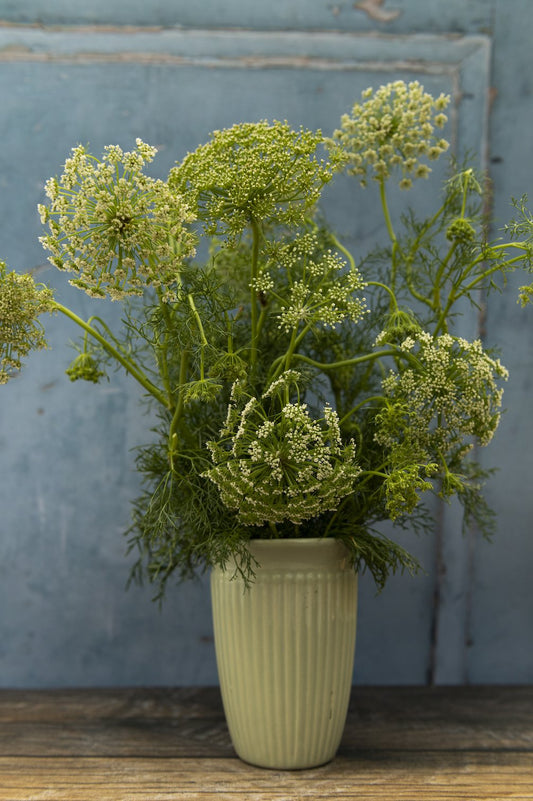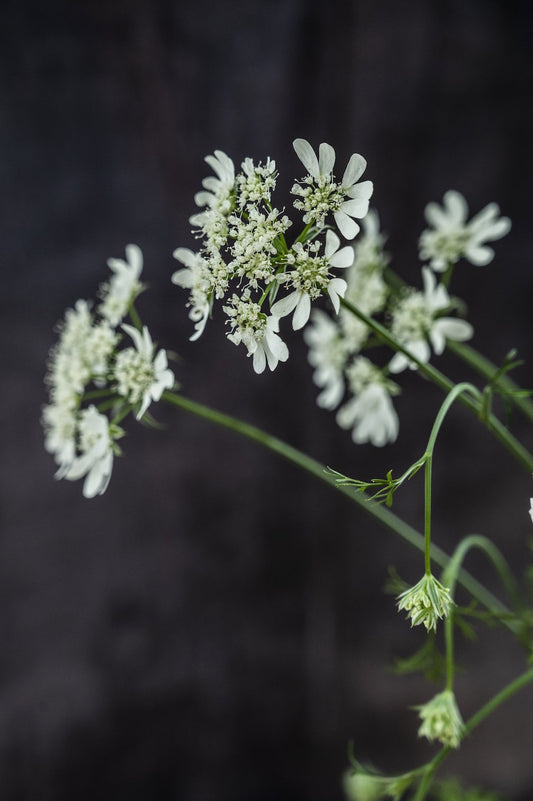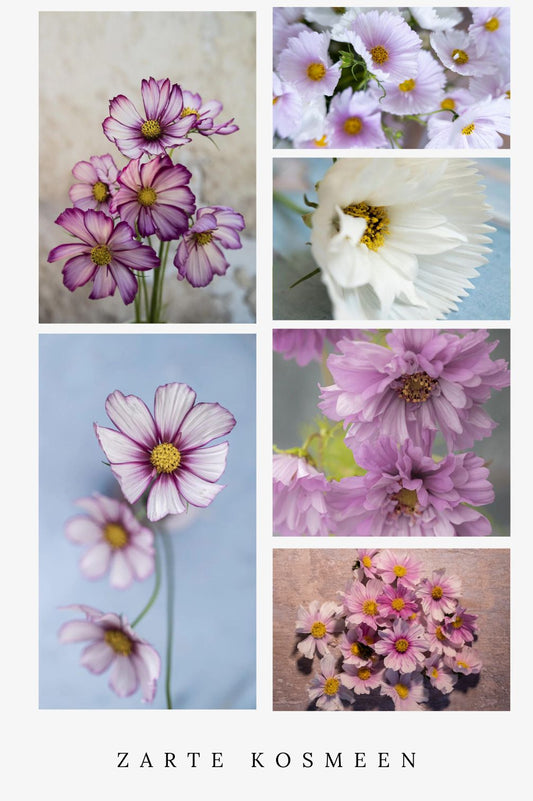THE COTTAGE GARDEN IN A VASE – The best cut flowers from your own garden
Actually, I only wanted a garden so that I could put a fresh bouquet of flowers on my table every day.
Maybe that's a bit of an exaggeration. But only a bit.

Now I have it, this garden.
And funnily enough, now I think three times about every flower, whether if I cut it off, I might leave a gaping hole and completely ruin the overall look of the garden forever. It's funny because my garden is a sea of flowers. It's practically overflowing with blossoms. Okay, that's a bit of an exaggeration. But only a bit.

Still, every time I want to pick up a fresh bouquet, I'm hesitant. Will anyone notice if I cut this rose now? If I harvest the sweet peas and put some snapdragons in a vase? Will the garden be completely empty? Will everything be ruined?
No, of course not.
To overcome my doubts, I started planting cut flower beds a few years ago. For space reasons, since my garden is already overflowing, I planted them in raised beds. So I could make big, fat bouquets without restraint and (almost) without a guilty conscience. Every day. Because with most summer flowers, the more you cut, the more new blooms they will give you.
The truth is (please excuse my unromantic pragmatism), but a flower blooms for one reason only: it has to reproduce. Once it has done that, i.e., set seeds, its job is done, it sits back and relaxes, and pretty quickly stops blooming. And then that's the end of the sea of blossoms.
That's why—and I have to tell myself this again and again—you can safely cut off many of the flowers. This will encourage the plant to become even more active and produce new blooms.
A few important tips in advance:
- It is best to water the flowers well again the evening before cutting, so that they can recover from the warm, dry air of the summer day at night.
- It's best to prune early in the morning. The flowers will have absorbed enough water overnight and will therefore last longer.
- Use a sharp knife or scissors for a clean cut. (Ragged snipping will damage the flowers' vascular pathways.)
- Cut diagonally if possible to increase the cutting surface. This allows the flowers to absorb more water.

This way you can enjoy your vase splendor for longer:
- Find a vase of the right size. It's okay for the flowers to have some air space inside. Firstly, it looks nicer, and secondly, their vascular systems can be damaged if they're squashed into vases that are too small.
- Rinse the vase and clean thoroughly. Old flower water or flower residue can contain bacteria that shorten its lifespan in the vase.
- Ideal flower water is lukewarm and low in lime. Change the water approximately every two to three days and repeat the cutting process.
- Only place stems without leaves in the water. Remove leaves up to about the height of the vase's rim; they will rot in the water.
- Even if it sounds exaggerated, keep a bucket or vase handy in the garden and immediately place it in water as soon as you cut the flowers. This reduces stress for our flowering favorites.
- A cool spot is good for them – so don’t place them in direct sunlight and ideally outside at night.
And these are my stars in the vase:
Daffodils
Beautiful spring bloomers that finally bring life back to the garden after the winter. I celebrate every single one that bravely poke its head out of the ground. And it doesn't have to be the classic yellow daffodil. There are so many wonderful, charming varieties available these days.

Acropolis (available again from autumn).
If you click on the link, you can sign up – then you will receive a message from me when they are available again.
Cut: As soon as the flowers begin to open.
Shelf life: approx. one week.
Good to know: Daffodils and other early bloomers like hyacinths and lilies secrete a toxic sap that significantly shortens the lifespan of other flowers. Before placing daffodils in a vase with their companions, leave them in a separate vase for a few hours after cutting. This will prevent the stem ends from closing (do not cut them again!) and from secreting mucilage.
Tulips: Simply always beautiful in spring. For me, thick, fat bouquets of tulips are the epitome of spring: Now everything is starting to bloom again! But tulips are also always wonderful individually in small vases.


Pruning: They stay beautiful longest when pruned in bud. The buds should no longer be hard, but should be easy to squeeze and already show some color.
Shelf life: Five to seven days. Peonies need a lot of water.
Good to know: You can also store cut peonies in the refrigerator for a few days if, for example, they were already ready to be cut, but the rest of the flowers for your planned bouquet aren't ready yet. Simply tie them together, remove the leaves, wrap the cut surfaces with kitchen paper, and place them in water. They can then wait until they're ready to use.
Ground elder
You weren't expecting this one here? Honestly, neither was I. But as I was going through my photos to gather the images for this post, I stumbled upon this photo and think it goes incredibly well with roses. And we caught it before it can seed (which probably doesn't matter with the ground elder, unfortunately)...

Cut & Durability: It doesn't last forever, but there's usually enough supply in the garden.
Good to know: Most people curse it as a weed – but at least it should bring us joy in the house.
Cosmos
No summer bouquet is complete without cosmos. They convey the lightness and carefreeness of warm days and, for me, are the epitome of a summer flower. It's not for nothing that they are also called "cosmos."

Cupcake Blush and Cupcake White – so enchanting.
Cutting: Harvest the flowers when they are still closed but already showing some color.
Shelf life: Four to six days.
Good to know: The more you prune them, the more flowers they will give you. A grateful little plant!
Click HERE to see the cosmos in the Cottage Garden Shop.
Snapdragon
I saw it once and was immediately captivated. Since then, it has delighted me every year, both in the garden and in a vase.
Pruning: Snapdragons are pruned when about one-third of the flowers are open.
Shelf life: about one week, longer if stored in a cool place (preferably outside at night). They require a long, diagonal cut and plenty of water.
Good to know: Once seeds have formed, the flowers stop blooming. So get them in time. Amazingly, as annuals, some of them even survive the winter well.
Sweet peas
These delightful little flowers are never-ending flower factories. You cut them, they make new ones, you cut them the next day, they make new ones again – and it goes on all summer long! Plus, they're simply enchanting with their fragrance. There's no better souvenir.
Pruning: Best when not all the flowers on a stem have opened yet. But it doesn't really matter; it will shower you with blossoms anyway.
Shelf life: A few days, but...
Good to know: ...You have to prune them regularly anyway. Because once they set seed, their blooming is over. In return, you'll have the happiness and scent of summer in all its hues in your home almost every day.
HERE you will find the most beautiful sweet peas that I have selected for you 💚
Sedum
This plump bird is probably not your typical textbook vase flower. But I wonder why not? It still looks beautiful even after it's finished blooming. And it even forms new roots in the vase. Each stem will become a new plant, should you plant it.

Pruning: Cut it above a leaf, and it will sprout again from that point. You can prune it at any stage from summer to fall.
Durability: None last as long (weeks!!! really!!!!) as a cut flower.
Good to know: It tolerates standing in its moldy water. So if water changes are too much trouble for you, go for stonecrop!
Dahlias
Dahlias are wonderful cut flowers. They come in all shades, and they'll ensure your vases never remain empty: The more you harvest, the more new blooms they produce.

Cut: When the flowers are almost completely open except for the middle – not much is happening in the vase at that point.
Durability: Change the water every day. Remove the leaves—they rot if they stand in water. Unfortunately, they don't last very long in a vase, but after a few days, the new plants in the garden will bloom.
Good to know: Water the plants as soon as they are cut, so place a bucket of fresh water next to them in the bed.
I was out looking for some really beautiful dahlias. They're all in the shop now, check HERE !
roses
The queen of flowers. My queen. In the garden and in the vase. Wonderful to combine. With so much!
Shelf life: Depending on the variety, three to five days
Good to know: Keep refrigerated if not used immediately.
Cornflower: As much a part of summer as the blue sky and the rustling of the summer breeze through the leaves. Cornflowers used to be found everywhere along the edges of grain fields; today, they hopefully appear in our colorful summer bouquets.
Cut: When the flowers are half open
Shelf life: Six to ten days
Good to know: You can dry cornflowers easily and thus extend the summer, at least indoors.
Virgin in the Green
After wilting, the delicate flower forms decorative, "inflated" seed pods that are ideal for drying and flower arrangements. It gets its name from the flowers, which resemble little skirts.
Cut: When the flowers have almost fully opened
Shelf life: About one week.
Good to know: It's perfect as a dried flower in arrangements. Its seed pods are also beautiful, both in a vase and dried.
Sunflowers
Endless fields, stretching to the horizon, full of these almost man-sized flowers, all turning their bright yellow heads towards the sun.
If anything symbolizes summer, it is the sunflower.
Cut: As soon as the flowers begin to open.
Shelf life: Remove the leaves at the bottom of the stem, it will last up to ten days in the vase
Good to know: After cutting, dip them briefly in hot water to extend their life as a bouquet.
Masterwort
It captivated me with its understated elegance. It looks great in colorful summer bouquets and, of course, in flowerbeds.

Cut: When the flowers have just opened.
Durability: Needs fresh water daily, lasts up to eight days in a vase.
Good to know: This delicate flower also thrives in shady places.
Orlaya grandiflora
This extraordinary beauty is relatively unknown. Its flowers resemble delicate lace. It's especially beautiful as a filler plant in bouquets.
Cutting: When the flower is almost fully open. After harvesting, hold the cut end of the stem in boiling water for about 10 seconds (see "Good to Know" below). Shelf life: about five days.
Good to know: The radiate broadleaf is a native plant species. Unfortunately, it is rarely found in the wild and is on the Red List of critically endangered plants.
Autumn anemone
She looks like a sophisticated ballerina with all the airs and graces, but in reality she's a rosy-cheeked, robust country girl. So, feel free to cut and fill your vases with this little dancer of the cottage garden.

Cut: When a quarter of the flowers on a stem are open. Shelf life: about one week.
Good to know: It reproduces spontaneously in the garden. Snails, its natural enemies, are eliminated. However, it's extremely easy to care for—you basically don't have to worry about it at all, other than enjoying it.
Carrot, wild carrot, ornamental carrot
Not a vegetable that's out of control, but the delicately flowering ancestor of our carrots on the plate. In shades ranging from white or, as in the case of the ornamental carrot, from the lightest antique pink to wine red and even chocolate, it's wonderfully beautiful in large bouquets and flower arrangements. A great filler plant!


Cut: When the flowers are almost fully open. Shelf life: Six to eight days.
Good to know: After cutting, hold the stems in boiling water for a few seconds. Incidentally, the green seed heads of the wild carrot also look pretty in a vase.
Hydrangeas
A wonderful vase flower, both fresh and dried. Since they don't respond to cutting with new flowers, I'm a bit hesitant about cutting them. But I can reassure you (and myself), even with hydrangeas, a bloom here and there isn't noticeable.

Pruning: The flower should be fully open. Or, if you want to dry it, only prune it when the flowers begin to change color. And remove most of the leaves.
Durability: If they are always kept deep in water, they last a long time.
Good to know: If you can wait until fall, you can simply dry the flowers. They look lovely in wreaths.
Night violet
It glows and smells particularly special at dusk, and insects are magically attracted to it.
Cut: When the first flowers open on the stem.
Shelf life: Five days.
Good to know: Like the tulip, the night violet continues to grow in the vase.
Sea lavender
Statice, or sea lavender, is the perfect flower for a dried bouquet.


Cut: When in full bloom.
Durability: Forever.
Good to know: For dried flowers, I hang them upside down to dry.
If you are looking for sea lavender, look HERE !
sage
A wonder herb – healthy and delicious. And it brings the South into our garden. Sage delights us with pink and purple flower buds that also look very pretty in a vase. But I like the leaves best in a bouquet.

Editing: As you please.
Durability: Long.
Good to know: Sage leaves are among the most important medicinal and aromatic plants. They can also be dried, giving pasta and other dishes a taste of the sunny south, even in winter.
yarrow
It is also known as a medicinal plant. This robust (companion) perennial enchants any garden and provides valuable food for insects, especially butterflies. Yarrow is also beautiful as a dried flower. And it comes in a variety of colors.
Cut: Only when almost all the flowers are open – this way it will last longer in the vase.
Shelf life: approx. one week.
Good to know: Yarrow quickly darkens the water, which doesn't look good in transparent vases. If this bothers you, you can add a few drops of bleach to the water.
Gypsophila
The delicate, seemingly inconspicuous flowers are often used to lighten up large bouquets. Gypsophila alone in a vase has a special charm—very airy, almost transparent.
Pruning: Cut when a little over half of the flowers on a stem are open.
Shelf life: Five to ten days. Often longer.
Good to know: It looks very romantic and has a charm all its own. Perfect as a bridal bouquet and flower wreath for the hair.
phlox
A wonderful cut flower and magical to combine. There are countless varieties of phlox in every imaginable color, from white to pink, red, and purple, in all shades, sometimes even bicolor. Phlox is known for its particularly vibrant colors, which is why it is also called "flame flower."

Cut: After two or three individual flowers have opened.
Shelf life: Five to seven days.
Zinnias
Zinnias have a certain nostalgia about them—a picture-perfect summer flower. They're very easy to care for and uncomplicated, and they, too, reward the harvest with a zealous supply of new buds.
Cut: just before the flowers are fully open.
Shelf life: Up to ten days.
Good to know: Before cutting, gently shake the flower's stem. If the stem is limp and the blossom is leaning, it's too early to cut. And like yarrow, zinnias also turn the water black, which doesn't look good in clear vases. If this bothers you, you can add a few drops of bleach to the water.
(Shrub) Ivy
Wonderful foliage, but also the green-yellow flowers and black berries look great in bouquets.
Cut: Anytime.
Durability: Very long, roots usually appear at some point.
Good to know: If you have sensitive skin, it is best to wear gloves.











